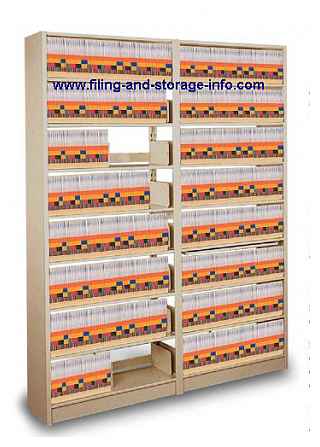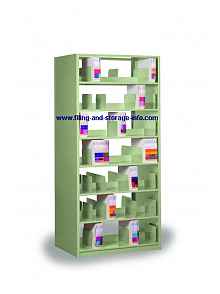The Secret to Maximizing File Storage Space starts with using File Shelving!

Static Open File Shelving is the most cost effective form of active file storage equipment available in the marketplace.
At a around $1.35 per linear filing inch in cost, static file shelving is easily 1/3 the price of Lateral File Cabinets.
So if your boss has told you to go out and find some cost efficient "READ" cheap file cabinets you are at the right place! Nothing is more cost efficient for active file storage than file shelving.
A perfect example of my point is to take a look at the typical medical filing system found in a doctor's office. Most medical charts are stored in shelving. Doctor's are under constant pressure to reduce the cost of care. They gravitate toward shelf filing because the cost of equipment is lower per Linear Filing Inch of any other options. An added benefit is that shelving occupies far less floor space per Linear Filing Inch of storage capacity than file cabinets. So they don't have to lease as much floor space.
{Space Saving Tip} Static File Shelving occupies about 1/3rd of the floor space of a Lateral File Cabinet (3 sq ft. vs 8.25 sq. ft.).
Types of File Shelving

Four Post File Shelving- is the first and most prevalent style of file shelving in the market today. Aurora Steel patented the product back in 1961 under the name of Aurora Quik-Lok Shelving. When the patent ran out, others manufacturers got into the business, some are better than others but Aurora has always remained the leader within the industry.
What makes four post shelving unique is that no nuts or bolts are required in the general assembly of the product. There are three main components, uprights, shelf supports and shelves. Uprights make up the sides of a section of shelving, two shelf supports per level lock into key holes with a mallet and shelves are placed on top of the shelf supports.
This style of shelving is very strong and when assembled very rigid as if it were made from one piece of steel. Units can be fit with a large assortment of accessories to accommodate all types of media. File dividers, drawers, pullout reference shelves and locking doors are just a few accessories available. The range of colors and sizes also allows the product to fit into almost every office or storage environment.
If you need help laying out a room with four post shelving or need pricing, click here for a quick response.
Four post shelving remains the most cost efficient of the file shelving options in the market today. But their are some other options, so lets take a look.

Stackable File Shelving-unlike four post, is assembled in complete tiers. If you look at the picture to the left you will see the line where the tiers meet when they are stacked on top of each other. I believe that stackable shelving was originally invented by a company called Supreme under the Thinline product name. It has subsequently been copied by others over the years, again with some doing a better job that others. Datum does a nice job with this product.
If you have existing stackable shelving and need more, or are interested in learning more about this product please click here for assistance.
One of the unique aspects of stackable shelving is each level has a lower profile than four post. So in certain applications where ceiling height or fire code get in the way of using four post shelving, stackable may still allow us to fit without sacrificing a level of storage. A drawback to stackable shelving is it is deeper than four post shelving. A letter size stackable shelving unit is 13.375" d while a four post unit is 12" d that extra depth can have an effect the number of units that will fit in a room. I have been in situations where that extra 1.375" did not allow us to fit as many units into a system and maintain proper access aisles. So it all depends on the situation and taking a proper survey.

Cantilever File Shelving- is virtually identical to cantilever library shelving in design and appearance. I don't know the origin but it was often sold by companies like Kardex and Tab Products. While I find older installations of the product quite often I don't see it being sold very frequently in today's marketplace.
When compared to four post or stackable shelving, cantilever has only one advantage, which is in the area of shelf adjustment. All the shelves hang from a frame located at the back of the unit in single faced units or the middle in double faced units. Shelf adjustment is accomplished by lifting and moving. Four post shelves can also be adjusted but require a little more effort and stackable shelves cannot be adjusted at all. While ease of shelf adjustment sounds great, in reality there is little need to adjust a shelf in a file room because 99.9% of the time every file will be the same height.
The downside to cantilever is mainly space efficiency but price can also be an issue. Depth wise, it is similar in depth to stackable shelving because of a 2.5" center support frame which hold the shelves. In terms of height you can normally fit 7 levels of filing where four post and stackable can fit 8 levels of filing. Price wise I have always found cantilever to be more expensive than four post but on par with stackable. Beyond the types of file shelving described above, there are a few other hybrids. However they are so far and few between I don't see the need to cover them in this forum.
Shelving is the foundation of the file shelving method of filing that we discussed on the
File Storage Equipment Page. Over the years the file shelving method has been expanded to include movement of the shelves with products like Side to Side Shelving, Mobile Shelving, Horizontal Carousels, Rotary Files or even Vertical Carousels. Equipment with the capability of movement enables us to put files in places static shelving could never go and use space that static shelving could never use. Static file shelving is the foundation all these other products developed from.
If you have a project or questions you need help with contact me by clicking here.